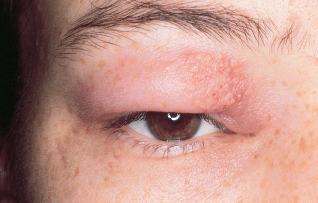Can You Identify These Periorbital Lesions?
Case 1:
For several weeks, this 72-year-old man has had progressive periorbital edema (A) that was initially thought to be allergic in nature but has become more pronounced and per- sistent. During the same period, jugular venous distention (B) with- out hepatojugular reflux or pedal edema has been noted.
What might explain these findings? 
Case 2:
What would you consider in the differential diagnosis of the vesicular rash near this woman’s eye?

Case 3:
One evening, this 40-year-old woman suffered a bout of gastroenteritis accompanied by nausea and vomiting. When she awoke the next morning, she noted these multiple red lesions around her eyes, and she sought medical care.
What is the likely cause of the petechiae? 
Case 4:
Sudden swelling of one eyelid led to an initial suspicion of periorbital cellulitis in this 64-year-old woman (A), but examination of the eye reveals a proptosis (B).
What do you suspect is respon- sible for the proptosis? 
Case 1: Superior vena cava syndrome
The patient was found to have a superior vena cava syndrome caused by an occult carcinoma of the lung.
(Case and photographs courtesy of Dr William F. Keenan.)
Case 2: Herpes zoster
The vesicles were identified as herpes zoster of the fifth cranial nerve,
first division. Ocular herpes zoster generally occurs only if the virus infects the nasociliary branch of the fifth nerve, which did not happen in this
case. The rash was differentiated from extraocular herpes simplex by the fact that the latter does not follow a dermatomal pattern. The rash resolved without treatment.
(Case and photograph courtesy of Dr Daniel L. Savitt.)
Case 3: Postemesis purpura
The Valsalva maneuver associated with vomiting caused delicate facial vessels to rupture.
(Case and photograph courtesy of Dr David I. Wolf.)
Case 4: Metastatic breast carcinoma
CT studies revealed the protrusion clearly; a scan cut taken a few millimeters caudad demonstrated the mass lesion responsible for the proptosis. The mass was found to have resulted from metastatic breast carcinoma. n
(Case and photographs courtesy of Dr William F. Keenan.)


